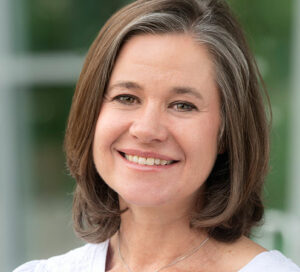Clinician Interview: Becky Breaux, MS, OTR/L, ATP
Clinician Interview: Becky Breaux, MS, OTR/L, ATP
Michelle L. Lange, OTR/L, ABDA, ATP/SMS
 Becky Breaux is a research senior instructor / assistive technology specialist at the Assistive Technology Clinic, part of the Center for Inclusive Design and Engineering (CIDE) at the University of Colorado in Denver. Also based in the Denver metro area, I have had the pleasure of knowing Becky for over 15 years. We sat down to discuss Dynamic Seating recently.
Becky Breaux is a research senior instructor / assistive technology specialist at the Assistive Technology Clinic, part of the Center for Inclusive Design and Engineering (CIDE) at the University of Colorado in Denver. Also based in the Denver metro area, I have had the pleasure of knowing Becky for over 15 years. We sat down to discuss Dynamic Seating recently.
Becky, how long have you been in this field and how did you get started in wheelchair seating and mobility?
Becky has been an Occupational Therapist for 27 years, graduating from the University of Missouri and later earning her Master’s degree with an emphasis in Assistive Technology at University of Oklahoma Health Sciences Center. Her first position was working with inpatients at a pediatric rehabilitation hospital in OK. Many of these kids needed a temporary wheelchair while in the hospital and some needed a wheelchair to go home in. Becky and other team members were making their own temporary seating systems to meet the immediate needs of these children. After working in this position for 2 years, the person who coordinated the wheelchair seating clinic left and Becky stepped in. Becky eventually moved to the Denver area and has been in her current position for about 15 years.
Over time, Becky came to believe that for many clients, long-term progress was limited without Assistive Technology (AT). She was a practical clinician and wanted to see real results. AT, including wheelchair seating and mobility, provided those results.
Why did you first start using Dynamic Seating? What were your goals?
About 10 years ago, Becky started using Dynamic Seating with some of the clients she worked with. She noted that certain clients with increased muscle tone and /or extraneous movements were:
- breaking equipment repeatedly,
- not staying in position in relation to the seating system,
- and / or injuring themselves.
Her initial goals were to prevent equipment breakage, help keep clients in alignment, and prevent injury.
What are your typical goals for Dynamic Seating with clients now?
Becky’s goals now focus more on the client and include:
- reducing pain
- increasing sitting tolerance
- reducing incidence of the client not using the wheelchair because it is broken (i.e., having to stay in bed)
- increasing function by preventing loss of client position
Those are great goals!
Dynamic Seating can be life-changing!”
– Becky Breaux, MS, OTR/L, ATP
Do you have any examples of clients using Dynamic Seating?
Client A – Equipment Breakage, Injury, and GI issues. One client that Becky works with broke the footplates on his wheelchair about every 5 weeks. These extreme forces, secondary to increased muscle tone, also led to frequent injury. The client’s parents did not believe that Dynamic Footrests would prevent their son from damaging the wheelchair, however Becky convinced them to try. After receiving Seating Dynamics Dynamic Footrests, this young man has had no further footplate breakage. This same young man has significant gastrointestinal (GI) issues, leading to quite a bit of trunk movement, including hip extension, in an effort to get more comfortable. Becky also recommended a Seating Dynamics Dynamic Rocker Back interface (DRBi) to allow this body movement without a loss of position.
Client B –Stability for Function and Wear and Tear: Another client Becky works with is in High School and has driven a power wheelchair using a joystick since age 5. He often extends with force (i.e., when talking or if startled). Using a Dynamic Back and Dynamic Footrests has provided the stability that he needs to be functional. Before receiving Dynamic Seating, this young man’s parents literally tightened screws on the wheelchair frame every other day to prevent this hardware from falling out and becoming lost.
Client C – Loss of Position and Skin Issues: Becky recommended Seating Dynamics Dynamic Head Support Hardware for a girl who sits in a molded seating system, the Aspen Seating Orthosis or ASO. This girl demonstrates repetitive torsion movements in her neck. This leads to movement throughout her body and she is often out of alignment with her seating system. She was having skin issues over her coccyx as a result. With the new molded seating system and Dynamic Head Support Hardware, she is staying in alignment with the ASO, and her skin issues have resolved.
Client D – Improved Power Wheelchair Driving: One girl working with Becky has cerebral palsy and significant dyskinesia. She has used a Dynamic Back and Dynamic Footrests on her power wheelchair which she drives well using a Head Array alternative driving method. This young lady wanted a standing power wheelchair which, unfortunately, is not compatible with any Dynamic Back or Dynamic Footrests. After discussing the pros and cons of continued use of Dynamic Seating or pursuing a standing wheelchair, the team moved ahead with the standing feature. Becky was concerned that this girl would not be able to drive well without the Dynamic Seating. Greg Peek, owner and chief designer of Seating Dynamics, custom made an interface to allow his Dynamic Head Support Hardware to work with an Adaptive Switch Labs Head Array. A prototype was tried at Becky’s clinic and this young lady drove very well. Becky notes that the Head Array responded well with posterior movement even when the client turned her head to turn the power wheelchair.
Thanks so much for sharing your Dynamic Seating experience, Becky, and keep up the great work!
